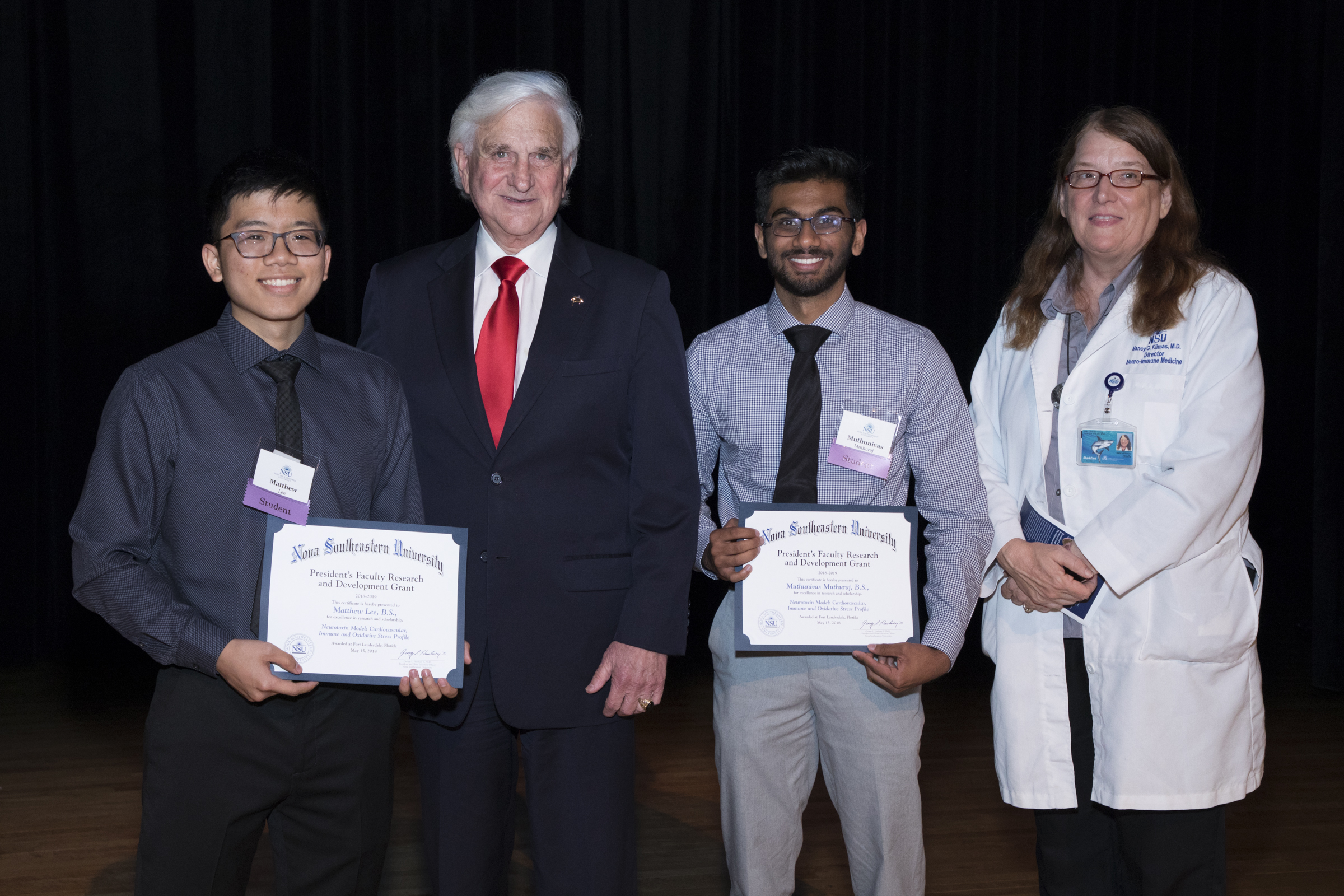Neurotoxin Model: Cardiovascular, Immune and Oxidative Stress Profile
Grant Winners
- Mariana Morris, Ph.D. – College of Pharmacy
- Jacqueline Freire Machi, Ph.D. – College of Osteopathic Medicine
- Nancy Klimas, M.D. – College of Osteopathic Medicine
- Rodrigo Schmidt, MS – College of Osteopathic Medicine
- Malav Trivedi, Ph.D. – College of Pharmacy
- Alin Benny, B.S. – Halmos College of Oceanography and Natural Sciences
- Darshan Rola, B.S. – Halmos College of Oceanography and Natural Sciences
- Matthew Lee, B.S. – Halmos College of Oceanography and Natural Sciences
- Muthunivas Muthuraj, B.S. – Halmos College of Oceanography and Natural Sciences
Deans
- Elaine Wallace, D.O., M.S., M.S., M.S. – College of Osteopathic Medicine
- Lisa Deziel, Pharm.D. – College of Pharmacy
Abstract

Gulf War Illness (GWI) is a multifaceted disease seen mainly in military personnel who served in the Gulf War. It is associated with cardiovascular/autonomic imbalance and immune dysfunction. There is also evidence that GWI is characterized by metabolic dysfunction such as metabolic syndrome (MS) increased brain oxidative stress and inflammation. There is little data concerning changes in cardiac immunological and oxidative stress systems and no information on effective treatments. We propose to extend our model, combining metabolic dysfunction (high fructose diet) with a cholinergic neurotoxin (DFP). The goal will be to test pharmacological agents - Enbrel (TNF-α inhibitor) and Mifepristone (glucocorticoid receptor antagonist) in addition to a chronic exercise paradigm. The agents, Enbrel and Mifepristone, were chosen on the basis of computer analysis of the structural and binding properties using pharmacogenomics databases. Studies indicate that Enbrel and Mifepristone may be act to prevent the cardiac dysfunction induced by exposure to the organophosphate, DFP. The proposal will use the GWI toxin model coupled with fructose intake. The key point is the evaluation of immunological and oxidative stress indices. The goal is to determine whether we can deliver an effective therapy with drugs (Enbrel, Mifepristone), exercise or a combination of treatments. Development of effective therapies in animals may be expanded to clinical tests.
 Gulf War Illness (GWI) is a multifaceted disease seen mainly in military personnel who served in the Gulf War. It is associated with cardiovascular/autonomic imbalance and immune dysfunction. There is also evidence that GWI is characterized by metabolic dysfunction such as metabolic syndrome (MS) increased brain oxidative stress and inflammation. There is little data concerning changes in cardiac immunological and oxidative stress systems and no information on effective treatments. We propose to extend our model, combining metabolic dysfunction (high fructose diet) with a cholinergic neurotoxin (DFP). The goal will be to test pharmacological agents - Enbrel (TNF-α inhibitor) and Mifepristone (glucocorticoid receptor antagonist) in addition to a chronic exercise paradigm. The agents, Enbrel and Mifepristone, were chosen on the basis of computer analysis of the structural and binding properties using pharmacogenomics databases. Studies indicate that Enbrel and Mifepristone may be act to prevent the cardiac dysfunction induced by exposure to the organophosphate, DFP. The proposal will use the GWI toxin model coupled with fructose intake. The key point is the evaluation of immunological and oxidative stress indices. The goal is to determine whether we can deliver an effective therapy with drugs (Enbrel, Mifepristone), exercise or a combination of treatments. Development of effective therapies in animals may be expanded to clinical tests.
Gulf War Illness (GWI) is a multifaceted disease seen mainly in military personnel who served in the Gulf War. It is associated with cardiovascular/autonomic imbalance and immune dysfunction. There is also evidence that GWI is characterized by metabolic dysfunction such as metabolic syndrome (MS) increased brain oxidative stress and inflammation. There is little data concerning changes in cardiac immunological and oxidative stress systems and no information on effective treatments. We propose to extend our model, combining metabolic dysfunction (high fructose diet) with a cholinergic neurotoxin (DFP). The goal will be to test pharmacological agents - Enbrel (TNF-α inhibitor) and Mifepristone (glucocorticoid receptor antagonist) in addition to a chronic exercise paradigm. The agents, Enbrel and Mifepristone, were chosen on the basis of computer analysis of the structural and binding properties using pharmacogenomics databases. Studies indicate that Enbrel and Mifepristone may be act to prevent the cardiac dysfunction induced by exposure to the organophosphate, DFP. The proposal will use the GWI toxin model coupled with fructose intake. The key point is the evaluation of immunological and oxidative stress indices. The goal is to determine whether we can deliver an effective therapy with drugs (Enbrel, Mifepristone), exercise or a combination of treatments. Development of effective therapies in animals may be expanded to clinical tests.